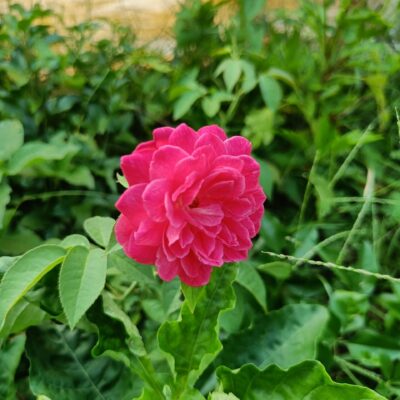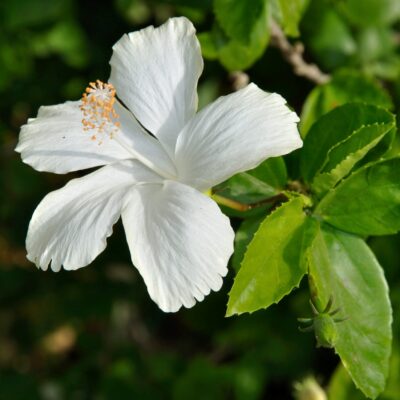Description
Hibiscus Pink- Sembaruthi
A flowering plant known as hibiscus is a member of the Malvaceae family and the genus Mallow. Hibiscus is the botanical name that all of the plants in it begin with because, generally speaking, it is not a name for just one plant but rather a collection of several hundred species.
This species, which is native to temperate, tropical, and subtropical areas of the world, is well known for its unusual, sizable, and vibrant flowers. Most often known as hibiscus and only infrequently as rose mallow, these plants are. As well as these names, it goes by Tropical Hibiscus, Rose of Sharon, and Hardy Hibiscus This genus contains all perennial herbaceous plants, and the species includes short shrubs, wood shrubs, small trees, and trees. Hibiscus Pink gives vibrant look to your garden.
In some tropical Asian regions, the perennial Hibiscus rosa-Sinensis plant is thriving. These medicinal plants, particularly those in India that are known as “Sembaruthi” in all homes, are grown for both aesthetic and therapeutic reasons. The Swedish botanist Carl Linnaeus gave the Hibiscus rosa-Sinensis species name and published it in his book “Species Plantarum” in 1753.
Other common names for these tropical hibiscus plants include China Rose, Rose Mallow, Chinese Hibiscus, Shoeblackplant, and Hawaiian Hibiscus. Even though the Latin word rosa-Sinensis means “Rose of China,” its flowers are not closely related to roses. These plants have glossy leaves and can develop into a shrub, an evergreen shrub, or a small tree that is 8–16 feet tall and 5–10 feet wide.
Other Language Names: Telgu-Mandara, Kannada-Dasvala
Common Name: China Rose, Rose mallow, Shoeblack plant.
Scientific Name: Hibiscus rosa-sinensis
Family: Malvaceae
Plant Type: Evergreen subshrub
Origin: India
Additional Information:
| Brand | Theorganicpot |
| Quantity | 1 |
| Common Name | Hibiscus |
| Flowering Plant | Yes |
| Suitable For | Outdoor, Indoor |
| Family | Malvaceae |
| Scientific Name | Hibiscus rosa-sinensis |
| Lifecycle | Perennial |
| Dimensions | 1 feet |
*Above specifications are indicative only. actual dimensions may vary by +-10%
Advantages
1. Has antifertility characteristics
Hormonal contraceptives, a form of artificial birth control, are now used by more than 100 million women worldwide. Although it has been established that this artificial method of preventing pregnancy can have several negative side effects for the majority of people, it is still the most popular. But research has revealed that hibiscus rosa-Sinensis has anti-fertility properties, making it effective as a natural contraceptive with no side effects when prescribed correctly.
2. Encourages Cardiovascular Health
One of the main factors contributing to heart disease is high blood pressure. If this condition is managed, the heart is not harmed. But when the blood pressure increases and the blood’s antioxidant pressure increases, it can significantly affect the heart.
3. Possibility of Fighting Cancer
Chemicals called antioxidants, which are typically made available to the body through the natural foods we eat daily, work to stop the damage from free radicals and control their effects. Hibiscus contains a lot of antioxidants that support the immune system’s defense against free radicals and help maintain their balance. Additionally, it guards against free radicals’ ability to harm other cells in the body.
4. Functions as a diuretic
According to research, the hibiscus plant contains significant amounts of the natural compounds known as diuretics, which are a class of natural substances that increase the production of urine. Diuretics speed up urination and stimulate the production of urine, which helps the body remove waste and toxic substances.
Benefits
- They are firstly lovely and frequently used as decorations.
- Hibiscus may be able to lower blood pressure, according to studies.
- Additionally, it can lower blood cholesterol, fat, and sugar levels.
- They can also lessen spasms in the uterus, stomach, and intestines.
- They also serve as decorations during weddings and other ceremonies.
- Hibiscus can be used to make a variety of industrial products, including tea and supplements.
Advantages
1) It has a significant commercial demand
2) Supplements can be found as capsules, tinctures, and powders.
3) They can also be used as a tea and as waxes.
4) Hibiscus tea is a beverage that people drink to cool off.
5) Also, it can be used to treat high blood pressure and heart conditions.
6) Additionally, they can strengthen the health of hair and are used as conditioners.
How we export
Around here at VGR Nurseries, we need to simplify it for any individual who wishes to purchase exceptional plants in mass at reasonable costs to do as such in a solitary area. We have an armada of vehicles and a serious group of experts to give you the quality and experience you need. We are sensibly evaluated and consistently trustworthy. A large number of our colleagues have been with the firm for over a decade. We just at any point give first-class establishes in enormous amounts, whether they are transported via airship cargo, ocean cargo, or both. We for the most part bargain in discount merchandise since we trust it to be the most meriting and savvy method for giving your hands a huge amount of living satisfaction.
Our Quality
Plants are bundled and stacked at VGR Nurseries in anticipation of the exportation of airship cargo and ocean cargo holders to nations across the world. Seek to go about as a broker picking the best makers and products for our most esteemed clients. The attributes of the plants and the fitting testaments are another issue. You might relax realizing that each request will be sent with a phytosanitary testament, which fills in as our organization’s confirmation of steadfastness and quality.
Steps to plant
Before you plunk your hibiscus in the ground, it is essential to invest a little energy in choosing and setting up the establishing opening. Assuming the water vanishes in no less than an hour that is adequate. Assuming it is as yet remaining there following an hour you are most likely planting into dirt or over another impermeable material and may wind up suffocating the hibiscus roots. Options are to develop a raised establishing bed or to revise the dirt with “mud busting” material accessible at most nurseries. By creating a small well at the top of the soil, you can determine how well water permeates your soil. The well should be filled with water two or three times, then left to drain for 30 minutes or so.




Reviews
There are no reviews yet.